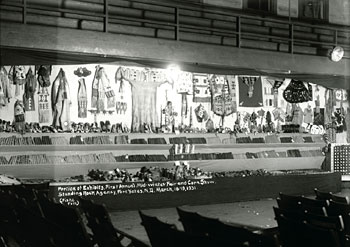
Portion of exhibits at first annual Mid Winter Fair & Corn Show
Standing Rock Agency, Fort Yates, ND, March 18-19, 1931
SHSND# 1952-0578The final fair to note among the records in the SHSND archive is the Fort Berthold or Indian Fair. The first of these took place in 1911 and there are records for 1912 and 1921 as well. The fairs combined traditions (complete with re-enactments of battles) and what the reservation agents considered to be demonstrations of progress made by the residents of Fort Berthold reservation toward “civilization.” The categories for premiums were quite simple as they were in the Indian class at the Morton County fairs. In 1911, entrants could compete with “corn, early Mandan corn, squash, early day squash, potatoes, tomatoes, cabbages, carrots, oats, wheat, sunflowers, beans, etc.” In 1912, there were prizes for the largest pumpkin, largest squash, largest turnip, largest beet, largest onions, and largest head of cabbage. There were prizes for the “nicest cup of jelly,” and the “nicest quart of fruit.” The prizes were fifty cents and twenty-five cents for jelly, and $1 for the largest vegetables. The second largest vegetables won fifty cents. The rules raise some questions. The exhibits were open to Indians “or those connected with Indian work.” The State Historical Society offered premiums in 1911 and 1912.
In 1921, the premium list grew to 15 vegetables including white, yellow, and red corn; white, speckled and black beans; tobacco, pumpkins, squash, turnip, cabbage, onions, carrots, watermelon, and potatoes. Size, again, was worth a prize. The prizes increased substantially to $5 for first place and $2.50 for second place. Preserves and jellies of plums and grapes were also awarded prizes.




